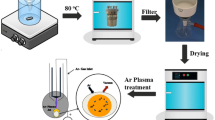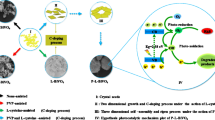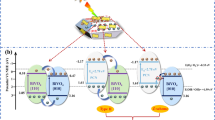Abstract
Crystal phase engineering was applied for BiVO4 via the introduction of N-doped CQDs (NCDs), in which the phase of BiVO4 was converted from monoclinic phase to tetragonal phase, generating a self-heterostructure. The intense heterostructure between NCDs and BiVO4 via strong electronic interaction, confirmed by the conversion of crystal phase and XPS results, led to the promoted separation and migration ability of photoinduced carriers. Moreover, the varied band structure (more negative Fermi level) of BiVO4 after the introduction of NCDs and the up-conversion luminescent property of CQDs led to the vast generation of O2−, which was confirmed to play a significant role during RhB photodegradation. However, there existed an optimal introducing amount of NCDs, confirmed to be 30 mg, which revealed 100% photodegradation efficiency after 180 min illumination. The decrease of photocatalytic activity in the condition of excessive NCDs introducing amount was ascribed to the aggregation of these quantum dots or the cover of the active plane of BiVO4 by NCDs. In addition, the photodegradation mechanism exploration revealed that both O2− and photoinduced holes acted as radical species during the photoreduction process, and O2− played more significant role.
Graphical Abstract









Similar content being viewed by others
References
Chen Z-M, Chen P, Lenzen M, Xiao B, Malik A (2022) Global embodied energy flow and stock analysis with endogeneous fixed capital. Environ Sci Technol 56(23):17197
Scheringer M, Johansson JH, Salter ME, Sha B, Cousins IT (2022) Stories of global chemical pollution: will we ever understand environmental persistence? Environ Sci Technol 56(24):17498
Hu X, Yang Y, Wang W, Wang Y, Gong X, Geng C et al (2023) Hollow Fe3+-doped anatase titanium dioxide nanosphere for photocatalytic degradation of organic dyes. ACS Appl Nano Mater 6(20):18999
Ahmadi A, Nezamzadeh-Ejhieh A (2017) A comprehensive study on electrocatalytic current of urea oxidation by modified carbon paste electrode with Ni(II)-clinoptilolite nanoparticles: Experimental design by response surface methodology. J Electroanal Chem 801:328
Nasiri-Ardali M, Nezamzadeh-Ejhieh A (2020) A comprehensive study on the kinetics and thermodynamic aspects of batch and column removal of Pb(II) by the clinoptilolite–glycine adsorbent. Mater Chem Phys 240:122142
Nezamzadeh-Ejhieh A, Moazzeni N (2013) Sunlight photodecolorization of a mixture of Methyl Orange and Bromocresol Green by CuS incorporated in a clinoptilolite zeolite as a heterogeneous catalyst. J Ind Eng Chem 19(5):1433
Mirsalari SA, Nezamzadeh-Ejhieh A, Massah AR (2022) A designed experiment for CdS-AgBr photocatalyst toward methylene blue. Environ Sci Pollut Res 29(22):33013
Gao X, Zheng M, Zhao X, Song S, Gao Z (2021) Ultra-high-capacity adsorption of Rhodamine B in a carboxyl-functionalized metal-organic framework via surface adsorption. J Chem Eng Data 66(1):669
Hidayat R, Wahyuningsih S, Fadillah G, Ramelan AH (2022) Highly visible light photodegradation of RhB as synthetic organic dye pollutant over TiO2-modified reduced graphene oxide. J Inorg Organomet Polym Mater 32(1):85–93
Vijayan K, Vijayachamundeeswari SP (2022) Improving the multifunctional attributes and photocatalytic dye degradation of MB and RhB dye—a comparative scrutiny. Inorg Chem Commun 144:109940
Zhou L, Wu Y, Jiang Q, Sun S, Wang J, Gao Y et al (2023) Pyrolyzed sediment accelerates electron transfer and regulates rhodamine B biodegradation. Sci Total Environ 905:167126
Li M, Dong B, Chang Z, Dang H, Ma S, Li W (2023) Synthesis of TiO2/g-C3N4 photocatalyst with recovered TiO2 from spent SCR catalyst for photodegrading rhodamine B. Waste Biomass Valorization 14(3):687–701
Arabpour N, Nezamzadeh-Ejhieh A (2016) Photodegradation of cotrimaxazole by clinoptilolite-supported nickel oxide. Process Saf Environ Prot 102:431
Joshi NC, Gururani P, Gairola SP (2022) Metal oxide nanoparticles and their nanocomposite-based materials as photocatalysts in the degradation of dyes. Biointerface Res Appl Chem 12:6557
Huang W, Li Y, Fu Q, Chen M (2022) Fabrication of a novel biochar decorated nano-flower-like MoS2 nanomaterial for the enhanced photodegradation activity of ciprofloxacin: Performance and mechanism. Mater Res Bull 147:111650
Baluk MA, Mazierski P, Pieczyńska A, Nikiforow K, Trykowski G, Klimczuk T et al (2023) MOF/TiO2 erythrocyte-like heterostructures decorated by noble metals for use in hydrogen photogeneration and pollutant photodegradation. Catal Sci Technol 13(17):5033
Lou T, Xu C, Guo Q, Song S, Wang Y, Gao X et al (2022) Hydroxyl-/carboxyl-rich graphitic carbon nitride/graphene oxide composites for efficient photodegradation of reactive red 195 and antibacterial applications. Langmuir 39(1):142
Rahmani-Aliabadi A, Nezamzadeh-Ejhieh A (2018) A visible light FeS/Fe2S3/zeolite photocatalyst towards photodegradation of ciprofloxacin. J Photochem Photobiol, A 357:1–10
Vahabirad S, Nezamzadeh-Ejhieh A, Mirmohammadi M (2023) A co-precipitation synthesized BiOI/(BiO)2CO3 nanocatalyst: An experimental design and mechanism study towards photodegradation of sulfasalazine. J Taiwan Inst Chem Eng 151:105139
Dong X, Li Y, Li D, Liao D, Qin T, Prakash O et al (2022) A new 3D 8-connected Cd(ii) MOF as a potent photocatalyst for oxytetracycline antibiotic degradation. CrystEngComm 24(39):6933
Zheng M, Cao X, Ding Y, Tian T, Lin J (2018) Boosting photocatalytic water oxidation achieved by BiVO4 coupled with iron-containing polyoxometalate: analysis the true catalyst. J Catal 363:109
Park G, Park JY, Seo JH, Oh KH, Ma A, Nam KM (2018) Ultrasonic-assisted preparation of a pinhole-free BiVO4 photoanode for enhanced photoelectrochemical water oxidation. Chem Commun 54(44):5570
Akrami S, Murakami Y, Watanabe M, Ishihara T, Arita M, Guo Q et al (2022) Enhanced CO2 conversion on highly-strained and oxygen-deficient BiVO4 photocatalyst. Chem Eng J 442:136209
Yousefi A, Nezamzadeh-Ejhieh A, Mirmohammadi M (2021) SnO2-BiVO4 mixed catalyst: characterization and kinetics study of the photodegradation of phenazopyridine. Environ Technol Innov 22:101433
Derikvandi H, Nezamzadeh-Ejhieh A (2017) Increased photocatalytic activity of NiO and ZnO in photodegradation of a model drug aqueous solution: effect of coupling, supporting, particles size and calcination temperature. J Hazard Mater 321:629
Noor M, Sharmin F, Al Mamun M, Hasan S, Hakim M, Basith M (2022) Effect of Gd and Y co-doping in BiVO4 photocatalyst for enhanced degradation of methylene blue dye. J Alloys Compd 895:162639
Yousefi A, Nezamzadeh-Ejhieh A (2021) Preparation and characterization of SnO2-BiVO4-CuO catalyst and kinetics of phenazopyridine photodegradation. Iran J Catal 11(3):247
Hemmatpour P, Nezamzadeh-Ejhieh A (2022) A Z-scheme CdS/BiVO4 photocatalysis towards Eriochrome black T: An experimental design and mechanism study. Chemosphere 307:135925
Luo S, Li S, Zhang S, Cheng Z, Nguyen TT, Guo M (2022) Visible-light-driven Z-scheme protonated g-C3N4/wood flour biochar/BiVO4 photocatalyst with biochar as charge-transfer channel for enhanced RhB degradation and Cr (VI) reduction. Sci Total Environ 806:150662
Liu J, Zhang H, Tang D, Zhang X, Yan L, Han Y et al (2014) Carbon quantum dot/silver nanoparticle/polyoxometalate composites as photocatalysts for overall water splitting in visible light. ChemCatChem 6(9):2634
Lim SY, Shen W, Gao Z (2015) Carbon quantum dots and their applications. Chem Soc Rev 44(1):362
Ye K-H, Wang Z, Gu J, Xiao S, Yuan Y, Zhu Y et al (2017) Carbon quantum dots as a visible light sensitizer to significantly increase the solar water splitting performance of bismuth vanadate photoanodes. Energy Environ Sci 10(3):772
Kumar MS, Yasoda KY, Kumaresan D, Kothurkar NK, Batabyal SK (2018) TiO2-carbon quantum dots (CQD) nanohybrid: Enhanced photocatalytic activity. Mater Res Express 5(7):075502
Xian T, Di L, Sun X, Li H, Zhou Y, Yang H (2019) Photo-Fenton degradation of AO7 and photocatalytic reduction of Cr (VI) over CQD-decorated BiFeO3 nanoparticles under visible and NIR light irradiation. Nanoscale Res Lett 14:1–14
Huang X, Zhang H, Zhao J, Jiang D, Zhan Q (2021) Carbon quantum dot (CQD)-modified Bi3O4Br nanosheets possessing excellent photocatalytic activity under simulated sunlight. Mater Sci Semicond Process 122:105489
Li L, Dong T (2018) Photoluminescence tuning in carbon dots: Surface passivation or/and functionalization, heteroatom doping. J Mater Chem C 6(30):7944
Wang G, Zhang W, Li J, Dong X, Zhang X (2019) Carbon quantum dots decorated BiVO4 quantum tube with enhanced photocatalytic performance for efficient degradation of organic pollutants under visible and near-infrared light. J Mater Sci 54:6488. https://doi.org/10.1007/s10853-019-03316-y
Zhang Z, Huang H, Xu J, Zhang N, Zhang C (2019) Carbon quantum dots/BiVO4 composite with enhanced photocatalytic activity. SCIENCE CHINA Technol Sci 62:356
Martindale BCM, Hutton GAM, Caputo CA, Reisner E (2015) Solar hydrogen production using carbon quantum dots and a molecular nickel catalyst. J Am Chem Soc 137(18):6018
Cao X, Gu Y, Tian H, Fang Y, Johnson D, Ren Z et al (2020) Microemulsion synthesis of ms/tz-BiVO4 composites: The effect of pH on crystal structure and photocatalytic performance. Ceram Int 46(13):20788
Hemmatpour P, Nezamzadeh-Ejhieh A, Ershadi A (2022) A brief study on the Eriochrome Black T photodegradation kinetic by CdS/BiVO4 coupled catalyst. Mater Res Bull 151:111830
Norouzi A, Nezamzadeh-Ejhieh A (2020) α-Fe2O3/Cu2O heterostructure: Brief characterization and kinetic aspect of degradation of methylene blue. Physica B 599:412422
Vahabirad S, Nezamzadeh-Ejhieh A, Mirmohammadi M (2022) The coupled BiOI/(BiO)2CO3 catalyst: Brief characterization, and study of its photocatalytic kinetics. J Solid State Chem 314:123405
Dabodiya TS, Selvarasu P, Murugan AV (2019) Tetragonal to monoclinic crystalline phases change of BiVO4 via microwave-hydrothermal reaction: In correlation with visible-light-driven photocatalytic performance. Inorg Chem 58(8):5096
Song Y, Wang Y, Hu C, Ye C, Qian Z, Zhao Y et al (2023) Facet Engineering-Induced Construction of Ni2P/ZnIn2S4 Heterostructures for Boosted Photocatalytic CO2 Reduction. ACS Appl Mater Interfaces 15:30199
Nguyen KG, Baragau I-A, Gromicova R, Nicolaev A, Thomson SA, Rennie A et al (2022) Investigating the effect of N-doping on carbon quantum dots structure, optical properties and metal ion screening. Sci Rep 12(1):13806
Liu Y, Wu P, Wu X, Ma C, Luo S, Xu M et al (2020) Nitrogen and copper (II) co-doped carbon dots for applications in ascorbic acid determination by non-oxidation reduction strategy and cellular imaging. Talanta 210:120649
Xu F, Cheng G, Song S, Wei Y, Chen R (2016) Insights into promoted adsorption capability of layered BiOCl nanostructures decorated with TiO2 nanoparticles. ACS Sustain Chem Eng 4(12):7013
Reddy CV, Nagar A, Shetti NP, Reddy IN, Basu S, Shim J et al (2023) Novel g-C3N4/BiVO4 heterostructured nanohybrids for high efficiency photocatalytic degradation of toxic chemical pollutants. Chemosphere 322:138146
Cai W, Yu X, Cao Y, Hu C, Wang Y, Zhao Y et al (2022) Electron-coupled enhanced interfacial interaction of Ce-MOF/Bi2MoO6 heterostructure for boosted photoreduction CO2. J Environ Chem Eng 10(3):107461
Tang J-y, Guo R-t, Zhou W-g, Huang C-y, Pan W-g (2018) Ball-flower like NiO/g-C3N4 heterojunction for efficient visible light photocatalytic CO2 reduction. Appl Catal B 237:802
Wan S, Ou M, Zhong Q, Zhang S, Cai W (2017) Supramolecular Synthesis of Multifunctional Holey Carbon Nitride Nanosheet with High-Efficiency Photocatalytic Performance. Adv Opt Mater 5(23):1700536
Cai W, Shi Y, Zhao Y, Chen M, Zhong Q, Bu Y (2018) The solvent-driven formation of multi-morphological Ag–CeO2 plasmonic photocatalysts with enhanced visible-light photocatalytic reduction of CO2. RSC Adv 8(71):40731
Farsi M, Nezamzadeh-Ejhieh A (2022) A Z-scheme Cobalt(II) oxide-silver tungstate nano photocatalyst: Experimental design and mechanism study for the degradation of methylene blue. Surf Interfaces 32:102148
Mehrabanpour N, Nezamzadeh-Ejhieh A, Ghattavi S, Ershadi A (2023) A magnetically separable clinoptilolite supported CdS-PbS photocatalyst: Characterization and photocatalytic activity toward cefotaxime. Appl Surf Sci 614:156252
Li X, Yu J, Low J, Fang Y, Xiao J, Chen X (2015) Engineering heterogeneous semiconductors for solar water splitting. J Mater Chem A 3(6):2485
Omrani N, Nezamzadeh-Ejhieh A (2020) Focus on scavengers’ effects and GC-MASS analysis of photodegradation intermediates of sulfasalazine by Cu2O/CdS nanocomposite. Sep Purif Technol 235:116228
Zhang Q, Huang Y, Xu L, Cao J, Ho W, Lee SC (2016) Visible-light-active plasmonic Ag-SrTiO3 nanocomposites for the degradation of NO in air with high selectivity. ACS Appl Mater Interfaces 8(6):4165
Leng WH, Zhang Z, Zhang JQ, Cao CN (2005) Investigation of the kinetics of a TiO2 photoelectrocatalytic reaction involving charge transfer and recombination through surface states by electrochemical impedance spectroscopy. J Phys Chem B 109(31):15008
Nosuhi M, Nezamzadeh-Ejhieh A (2018) An indirect application aspect of zeolite modified electrodes for voltammetric determination of iodate. J Electroanal Chem 810:119
Amani-Beni Z, Nezamzadeh-Ejhieh A (2018) NiO nanoparticles modified carbon paste electrode as a novel sulfasalazine sensor. Anal Chim Acta 1031:47–59
Dotan H, Sivula K, Grätzel M, Rothschild A, Warren SC (2011) Probing the photoelectrochemical properties of hematite (α-Fe2O3) electrodes using hydrogen peroxide as a hole scavenger. Energy Environ Sci 4(3):958
Kumar KV, Porkodi K, Rocha F (2008) Langmuir-Hinshelwood kinetics - A theoretical study. Catal Commun 9(1):82
Nezamzadeh-Ejhieh A, Banan Z (2012) Kinetic investigation of photocatalytic degradation of dimethyldisulfide by zeolite A containing nano CdS. Iran J Catal 2(2):79–83
Farsi M, Nezamzadeh-Ejhieh A (2022) A coupled Cobalt(II) oxide-Silver Tungstate nano-photocatalyst: Moderate characterization and evaluation of the photocatalysis kinetics towards methylene blue in aqueous solution. Polyhedron 219:115823
Nezamzadeh-Ejhieh A, Karimi-Shamsabadi M (2013) Decolorization of a binary azo dyes mixture using CuO incorporated nanozeolite-X as a heterogeneous catalyst and solar irradiation. Chem Eng J 228:631
Ghattavi S, Nezamzadeh-Ejhieh A (2020) A visible light driven AgBr/g-C3N4 photocatalyst composite in methyl orange photodegradation: Focus on photoluminescence, mole ratio, synthesis method of g-C3N4 and scavengers. Compos B Eng 183:107712
Acknowledgements
This work was financially supported by the National Natural Science Foundation of China (51808296, 51802160), the Startup Foundation for Introducing Talent of NUIST (2243141601034).
Author information
Authors and Affiliations
Contributions
WC contributed to the Conceptualization, Formal analysis, Supervision, Funding acquisition, and Writing-review & editing of the manuscript. JF contributed to the Conceptualization, Methodology, Formal analysis, and Writing-original draft of the manuscript. CH contributed to the Methodology and Formal analysis of the manuscript. YZ contributed to the Formal analysis and Funding acquisition of the manuscript.
Corresponding author
Ethics declarations
Conflict of interest
The authors declare no competing financial interest.
Additional information
Handling Editor: Pedro Camargo.
Publisher's Note
Springer Nature remains neutral with regard to jurisdictional claims in published maps and institutional affiliations.
Supplementary Information
Below is the link to the electronic supplementary material.
Rights and permissions
Springer Nature or its licensor (e.g. a society or other partner) holds exclusive rights to this article under a publishing agreement with the author(s) or other rightsholder(s); author self-archiving of the accepted manuscript version of this article is solely governed by the terms of such publishing agreement and applicable law.
About this article
Cite this article
Cai, W., Fu, J., Hu, C. et al. Crystal-phase engineering of BiVO4 induced by N-doped carbon quantum dots for photocatalytic application. J Mater Sci 59, 4118–4135 (2024). https://doi.org/10.1007/s10853-024-09480-0
Received:
Accepted:
Published:
Issue Date:
DOI: https://doi.org/10.1007/s10853-024-09480-0




